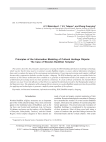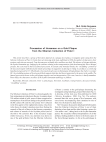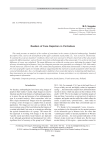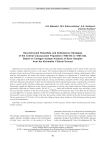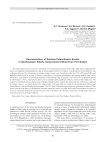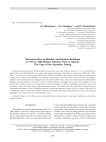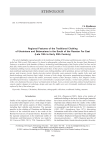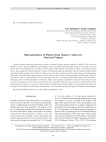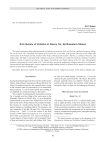Archaeology, Ethnology & Anthropology of Eurasia @journal-aeae-en
Статьи журнала - Archaeology, Ethnology & Anthropology of Eurasia
Все статьи: 524
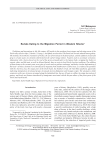
Prospection studies of Bohai graves near Kraskinskoye fortified settlement, Primorsky krai
Статья
Бесплатно
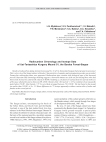
Статья научная
Results of radiocarbon dating of items from mound No. 51 of Ust-Tartasskiye Kurgany burial ground are presented. This is a key site of the Sargat culture in Baraba. Characteristics of samples and pretreatment procedure are provided. Twenty-four radiocarbon dates were generated. Radiocarbon ages correlate with biological ages of the deceased persons. Bayesian KDE chronology modeling suggests a short-term intense use of the site for burying those who died between the 3rd and 1st centuries BC. Based on MCMC-modeling, a conclusion is reached about two periods in the use of the space allotted for graves between 200–40 BC. Burials of the “first period” (~25 %) could have been repeatedly made before 150 BC. Most burials (~75 %) were likely arranged between 150–120 BC. The last burial in the mound (no earlier than 110 BC) is No. 13. Minor differences in 15N isotope apparently evidence various diets of males and females at the second period.
Бесплатно
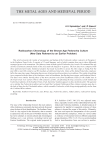
Radiocarbon chronology of the Bronze Age Fedorovka culture (new data relevant to an earlier problem)
Статья научная
This article presents the results of excavations and dating of the Fedorovka culture cemetery of Zvyagino-1 in the Southern Trans-Urals. It consists of 12 small kurgans, each of which contains from one to three differently arranged graves with cremations. The funerary items include typical Fedorovka clay vessels. We estimated the age of bones of domestic animals found on the area under the kurgan or in graves. The new dates were compared with those generated previously. Statistical analysis has made it possible to assess the time range as being from the mid-18th to mid-15th centuries cal BC (medians of calibrated intervals). Dates of the Alakul-Fedorovka complexes fall in the same time range, illustrating the process of interaction between these two traditions. The results of modeling were compared with the dates of the Andronovo sites in Kazakhstan, the Baraba forest-steppe, and Southern Siberia. The dates were similar, barring those of the more ancient series from Kazakhstan. Dates for the Alakul sites in the Trans-Urals were earlier (19th to 16th centuries cal BC), documenting the long coexistence of the Alakul and Fedorovka traditions. In the Southern Trans-Urals, the former tradition appears to have declined earlier. The question as to whether the Fedorovka tradition survived until the Cordoned (Valikovaya) Ware cultures remains open due to the lack of dates for the Cherkaskul culture, which resembles Fedorovka, while being stratigraphically earlier than the Cordoned Ware cultures.
Бесплатно
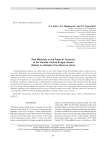
Статья научная
A multidisciplinary analysis of ceramics from six sites of the Surgut variant of the Kulaika culture at Barsova Gora was made. Technology was assessed using traceological, petrographic, and X-ray phase analyses. At all the sites, the potters used ferruginous clays tempered with grus, grog, sand, and organic material. Fragments in the clay were either rounded, as in sand, or coarse, as in grus. The sand was mainly represented by feldspar and quartz, suggesting that this type of raw material was extracted from nearby non-metallic mineral deposits. The grus consisted of fragments of basaltoids, amphiboles, and pyroxenes, evidencing that it came from igneous common rocks associated with the Surgut volcanic fi eld and spread over a large area. Rocks were probably mined near settlements, perhaps on the floodplain of the Ob. Grog in all the samples was similar to the basic clay in terms of its composition. Three groups of sites were identified, differing in the composition of the clay of which the ceramics were made. This may indicate the presence of several groups within the Iron Age Kulaika population, utilizing various sources of clay.
Бесплатно
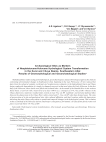
Remain s of tapestry from a Xiongnu (early 1st century ad) burial in mound 22 at Noin-Ula
Статья обзорная
Бесплатно
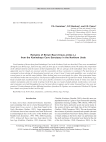
Remains of brown bear (Ursus arctos L.) from the Kaninskaya cave sanctuary in the Northern Urals
Статья
Бесплатно
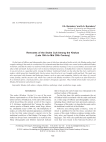
Remnants of the snake cult among the Khakas (late 19th to mid 20th century)
Статья обзорная
Бесплатно
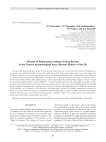
Статья
An especially noteworthy part of the Firsovo archaeological area is a group of early burials at the fl at-grave cemeteries Novoaltaisk-Razvilka, Firsovo XI, and Firsovo XIV. Nine radiocarbon dates have been generated for those cemeteries at various laboratories: two by the liquid-scintillation (LSC) method and seven using the accelerator mass spectrometry (AMS) method. The dates were calibrated using OxCal version 3.10 software. Dates for the Chalcolithic Bolshoy Mys culture burials at Novoaltaisk-Razvilka and Tuzovskiye Bugry-1 burial 7 match the previously suggested ones (around 3000 BC). Certain Neolithic burials in the Altai differ from others in the position of the bodies (fl exed on the side). They were dated to the late 5th to the early 4th millennia BC by the AMS method. Burials belonging to the “cultural core” of Firsovo XI, then, fall within the Early Neolithic (68 % interval, 5710–5460 BC; 95 % interval, 5740–5360 BC). The date 9106 ± 80 BP (GV-02889), obtained for Firsovo XI burial 18, may be somewhat accurate, pointing to the Final Mesolithic or Early Neolithic. Both the date and the cultural characteristics of this burial (sitting position, abundant ocher) are accompanied by the craniometric distinctness of the male cranium (huge total size).
Бесплатно
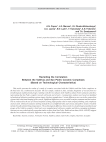
Статья научная
This article presents the results of a study of ceramics associated with the Valdivia and San Pedro complexes at the Real Alto site, southwestern Ecuador. The test sample, studied in 2022, includes fragments of vessels from two morphological and functional groups, relating to the first two phases of the Valdivia culture (bowls and pots) and those representing the San Pedro complex (vessels with necks and a bowl). A comparative analysis was based on identified technological indicators marking various stages of pottery manufacture. Certain differences are seen in the composition of paste and in the hand-shaping of the vessels. Significant differences were revealed in surface treatment and decoration. This is evidenced by the use of colored and plain coating, high-quality solid or matte striped polishing, and complexity of decoration. Distinctive features of firing include the use of different kilns and various atmospheric modes. Parallels include broadly similar firing temperatures. The technological difference between the two morphological and functional groups of the Valdivia complex is that bowls were manufactured with more complex and labor-consuming techniques, whereas pots are technologically somewhat similar to those from San Pedro. Radiocarbon dates (4640–4450 BP) suggest that the two traditions coexisted. Differences may reflect their cultural distinctness.
Бесплатно
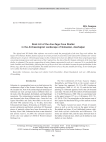
Rock Art of the Ana Zaga Cave Shelter in the Archaeological Landscape of Gobustan, Azerbaijan
Статья научная
The Agisoft and 3D Studio Max software was used to study the petroglyphs of the Ana Zaga rock shelter, the largest in Gobustan. Stylistic features typical of various periods are described, and radiocarbon estimates for various cultural layers are given. Chronological stages in the evolution of rock art are defined. On the basis of geological data concerning transgressions and regressions of the Caspian Sea, the date of the first human settlement of the Ana Zaga shelter is estimated. The species composition of extinct faunas represented in rock art is assessed. It is concluded that in the Neolithic and Chalcolithic, following the rise of the sea level, the rock shelter became the principal habitat. In the Bronze Age, after the sea level had fallen, the middle and lower terraces became suitable for living. As new landscapes were settled, the themes of petroglyphs changed.
Бесплатно

